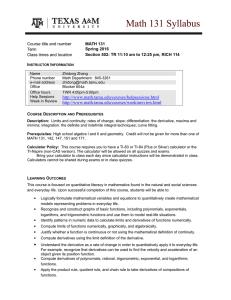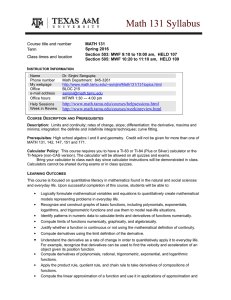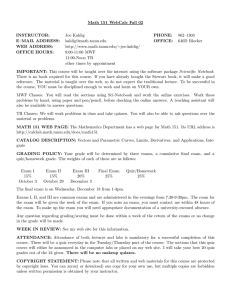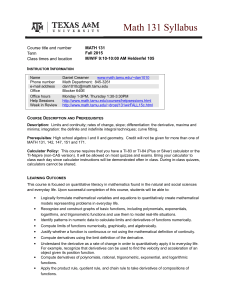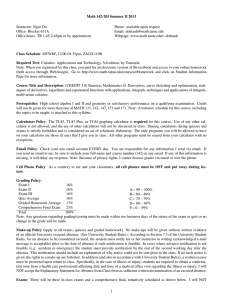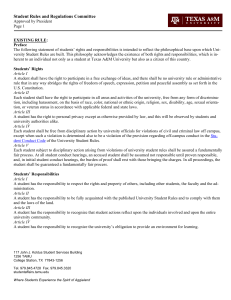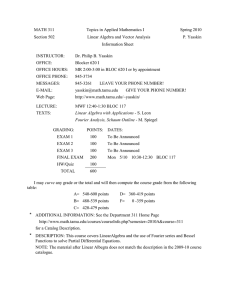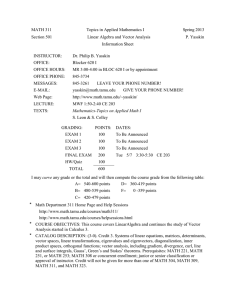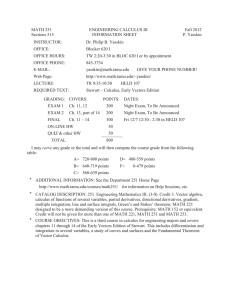Math 131 Syllabus Course title and number Term Class times and location
advertisement
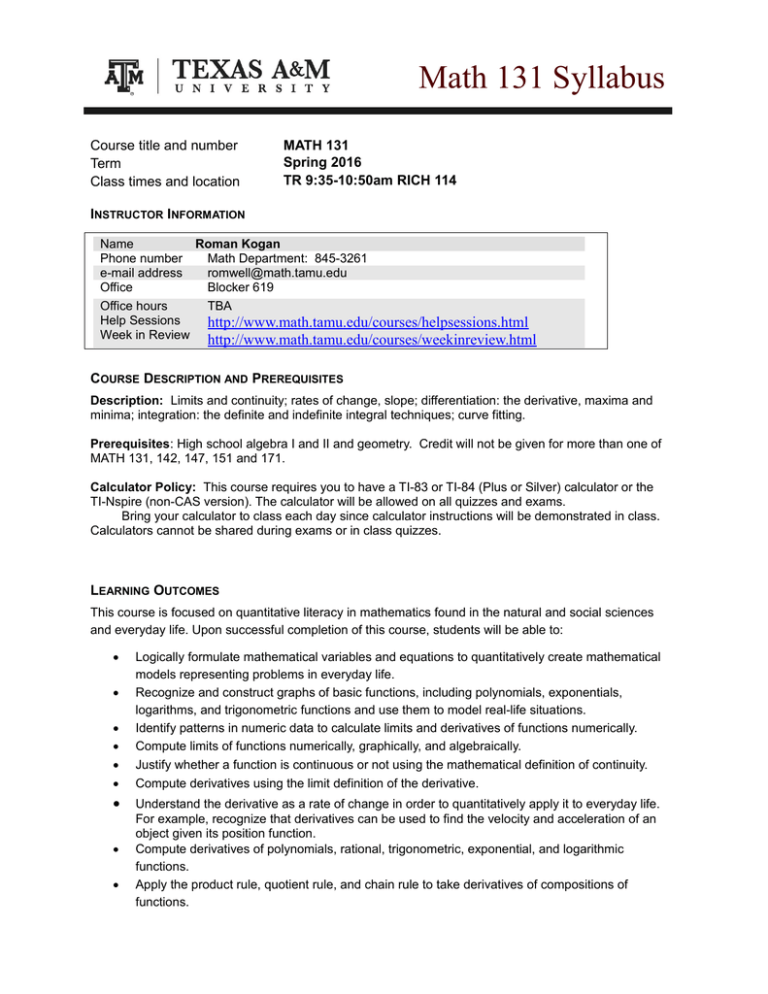
Math 131 Syllabus Course title and number Term Class times and location MATH 131 Spring 2016 TR 9:35-10:50am RICH 114 INSTRUCTOR INFORMATION Name Roman Kogan Phone number Math Department: 845-3261 e-mail address romwell@math.tamu.edu Office Blocker 619 Office hours TBA Help Sessions http://www.math.tamu.edu/courses/helpsessions.html Week in Review http://www.math.tamu.edu/courses/weekinreview.html COURSE DESCRIPTION AND PREREQUISITES Description: Limits and continuity; rates of change, slope; differentiation: the derivative, maxima and minima; integration: the definite and indefinite integral techniques; curve fitting. Prerequisites: High school algebra I and II and geometry. Credit will not be given for more than one of MATH 131, 142, 147, 151 and 171. Calculator Policy: This course requires you to have a TI-83 or TI-84 (Plus or Silver) calculator or the TI-Nspire (non-CAS version). The calculator will be allowed on all quizzes and exams. Bring your calculator to class each day since calculator instructions will be demonstrated in class. Calculators cannot be shared during exams or in class quizzes. LEARNING OUTCOMES This course is focused on quantitative literacy in mathematics found in the natural and social sciences and everyday life. Upon successful completion of this course, students will be able to: Logically formulate mathematical variables and equations to quantitatively create mathematical models representing problems in everyday life. Recognize and construct graphs of basic functions, including polynomials, exponentials, logarithms, and trigonometric functions and use them to model real-life situations. Identify patterns in numeric data to calculate limits and derivatives of functions numerically. Compute limits of functions numerically, graphically, and algebraically. Justify whether a function is continuous or not using the mathematical definition of continuity. Compute derivatives using the limit definition of the derivative. Understand the derivative as a rate of change in order to quantitatively apply it to everyday life. For example, recognize that derivatives can be used to find the velocity and acceleration of an object given its position function. Compute derivatives of polynomials, rational, trigonometric, exponential, and logarithmic functions. Apply the product rule, quotient rule, and chain rule to take derivatives of compositions of functions. Compute the linear approximation of a function and use it in applications of approximation and error estimation. Investigate the relationship between a function and its first and second derivatives, and use the information obtained from its derivatives to identify pertinent information about the function. Find the local and absolute extrema of functions, including optimization applications such as minimizing the cost of fencing in a particular area of land. Compute antiderivatives and understand the concept of integration as it relates to area. Recognize and appreciate the derivative (rate of change) and the definite integral (accumulation of change) and utilize the Fundamental Theorem of Calculus as the bridge between the two. Apply the substitution method to compute integrals. Apply the definite integral to quantitatively determine solutions to problems in everyday life including areas between curves, average value of a function, and total distance traveled. TEXTBOOK AND/OR RESOURCE MATERIAL Single Variable Calculus: Concepts & Contexts, 4th Edition, Stewart (2010) Note: An electronic version of this book will be available to you online via WebAssign Instructional videos will be posted weekly on GRADING POLICIES The course grading will be based on the results of In Term Exams: There will be 3 in term exams worth a total of 50% of your final score. Final exam: The Final exam will be cumulative and worth 25%. Homework: Online homework will be due weekly, every Wednesday by 11:55 pm. The homework will be available to you via WebAssign. Each assignment will have a practice set of problems which will not be graded and a homework set which will be graded. The 2 lowest homework scores will be dropped at the end of the term. Homework will be worth 10%. Quizzes/Take Home Assignments: The lectures and weekly instructional materials will include in-class and/or take-home quiz questions throughout the semester. Instructions will be provided in each case. Quizzes and assignments will make up 15% of your final score. Exams Timeline Activity Exam I Exam II Exam III Homework Quizzes/Take Home Assignments Final Exam TOTAL Grading Scale Range > 90% 80 ― 90% 70 ― 80% 60 ― 70% < 60% Grade A B C D F Date Percentage 50% Weekly Weekly 10% 15% 25% 100% Attendance and Make-up policies Excused absences: Attendance is mandatory and may affect your grade. For excused absences we refer the student to Student Rule 7 at http://studentrules.tamu.edu/rule7.htm. Excuses for absences during an exam must be substantiated by appropriate documentation. Falsification of documentation is a violation of the Honor Code. Make-up exams will be only allowed due to excused absences and the next possible make-up time be chosen from http://www.math.tamu.edu/courses/makeupexams.html. If you miss an exam, you have up to 2 business days to inform your instructor and plan your make up exam. If you foresee the need to be absent during an exam, you must notify the instructor in advance. COURSE TOPICS (Tentative weekly schedule) WEEK 1 2 3 4 5 6 7 8 9 10 11 12 13 14/15 TOPIC REQUIRED READING Functions, Models (emphasize function classes) Transformations of Functions, Exponential Functions, Inverses and Logarithmic Functions Approximating Slopes of Tangent Lines, Introduction to Limits, Calculating Limits Continuity, Limits Involving Infinity (excluding the Intermediate Value Theorem) Derivatives and Rates of Change, Review, Exam I Limit Definition of Derivatives, Slope Graphs and Antiderivatives, Derivatives of Polynomials and Exponential Functions Product and Quotient Rules, Derivatives of Trig Functions, Chain Rule, (excluding tangents to parametric curves and proving the chain rule) Derivatives of Log Functions, Applications in Natural and Social Sciences, Linear Approximations and Differentials (excluding logarithmic differentiation) Linear Approximations and Differentials, Review, Exam II, Local and Absolute Extrema Curve Sketching, Optimization (excluding trig optimization) Antiderivatives (excluding inverse trig functions), Approximating Area, The Definite Integral (excluding evaluating an integral by computing the limit of a Riemann sum) Evaluating Definite Integrals, Fundamental Theorem of Calculus, Substitution Review, Exam III, Area Between Curves (excluding parametric curves) Average Value of Functions, Applications to Biology, Introduction to Differential Equations (emphasize population growth), Review for Final Exam Sections 1.1, 1.2 Sections 1.3, 1.5, 1.6 Sections 2.1, 2.2, 2.3 Sections 2.4, 2.5 Section 2.6 Sections 2.7, 2.8, 3.1 Sections 3.2, 3.3 Section 3.7, 3.8, 3.9 Section 3.9, Section 4.2 Sections 4.3, 4.6 Sections 4.8, 5.1, 5.2 Sections 5.3, 5.4, 5.5 Section 6.1 Sections 6.5, 6.7 7.1* AMERICANS WITH DISABILITIES ACT (ADA) The Americans with Disabilities Act (ADA) is a federal anti-discrimination statute that provides comprehensive civil rights protection for persons with disabilities. Among other things, this legislation requires that all students with disabilities be guaranteed a learning environment that provides for reasonable accommodation of their disabilities. If you believe you have a disability requiring an accommodation, please contact Disability Services, currently located in the Disability Services building at the Student services at White Creek complex on west campus or call 845-1637. For additional information visit http://disability.tamu.edu ACADEMIC INTEGRITY For additional information please visit: http://aggiehonor.tamu.edu “An Aggie does not lie, cheat, or steal, or tolerate those who do.” In this course students can discuss homework assignments and solutions. However, it is NOT permissible to copy homework solutions from another student. It is NOT permissible to discuss any aspect of any test or examination until ALL students have completed the exam. The penalties for violating this policy will range from an F on an assignment or test, to failing in the course. Helpful links - Academic Calendar - Final Exam Schedule - On-line Catalog - Religious Observances http://registrar.tamu.edu/General/Calendar.aspx http://registrar.tamu.edu/General/FinalSchedule.aspx http://catalog.tamu.edu/ http://dof.tamu.edu/content/religious-observance
